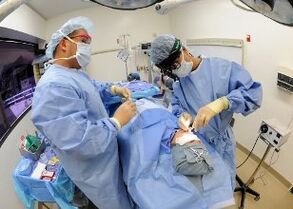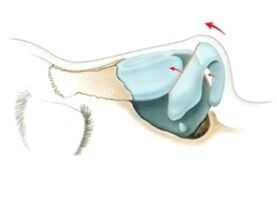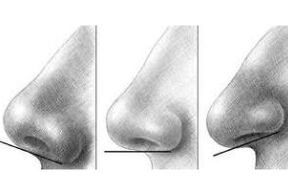
Rhinoplasty, or rhinoplasty, is a branch of plastic surgery that specializes in correcting congenital or acquired deformities, as well as repairing individual parts or entire organs of the nose.
Rhinoplasty can increase or decrease the size of the nose, change its shape and eliminate breathing problems. The aesthetic goal of rhinoplasty is to achieve harmony in facial features by correcting defects in the nose. Typically, this type of surgery is performed between the ages of 18-21 because of the physiological growth of bone and cartilage tissue before that.
The task of rhinoplasty is to restore the correct shape and function of the nose due to injury or damage during embryonic development. Rhinoplasty is a series of different surgeries that will be discussed in more detail below.
Clinics in Israel provide excellent results and the medical services provided meet the expectations of the patients.
In rhinoplasty in Israel, open or closed channels can be used depending on the purpose of the procedure. With closed rhinoplasty, an incision is made in the cavity and the skin is peeled from the frame (cartilage and nasal bone). This method is used to change shape, remove cartilage and excess bone, etc. If major surgery is planned, open rhinoplasty is prescribed when an incision is made in the columella (vertical skin fold that separates the nostrils).
Nose correction is divided into primary and secondary. Corrective or secondary plastic surgery is performed to remove defects that remain after the primary surgery.
In recent years, fillers have been actively used in rhinoplasty if minor defects of the nose need to be corrected: changing the shape of the wings, restoring symmetry, rounding the tip of the nose, etc.
Rhinoplasty in Israel: Planning and Implementation

At the Israeli clinic, the plastic surgeon first consults the patient, examining the shape of the nose, the condition of the tissues, and diagnosing nasal breathing disorders. For the best cosmetic results, photos and computer modeling of the nose are taken. An otolaryngologist also consults with patients. Rhinoplasty is performed in conjunction with an otolaryngologist and a plastic surgeon if there are obvious deficiencies, when nasal breathing is disturbed.
Typically, general anesthesia is combined with local infiltration anesthesia during surgery. The duration of a rhinoplasty depends on the complexity and can take 1-2 hours or more. To give the nose a more aesthetically pleasing size and shape, surgeons alter the bone and cartilage frame. Correct rhinoplasty in Israel and without complications - postoperative scars are practically invisible.
Recovery period after nose correction
After surgery, the tampon is installed in the nasal passage and removed 2-3 days later. To repair the new form, a special plaster or gel sticker is applied for 5 to 7 days (if the plastic touches the cartilaginous part of the nose) or 12 to 14 days (if the bone part).
Nasal breathing may be difficult for the first few weeks due to swelling. The bruising and swelling will go away within ten to fourteen days. Glasses are not recommended for one and a half months after nose correction. The entire recovery process will take six to eight months before the final results of the surgery can be seen. Smoking and taking certain medications can slow recovery.
Rhinoplasty in Israel: Removing the Hump of the Nose

The operation is multi-stage. During its implementation, the osteochondral protrusion at the rear of the nose was eliminated. Humpback can be caused by trauma or genetic factors.
If the hump of the nose is small, local anesthesia can be used, if it is large - normal. The duration of surgical intervention is 1-2 hours.
First, the surgeon dissects and removes the skin from the osteochondral base of the nose - the skeletalization stage. After that, the cartilage is dissected and the cartilaginous part of the septum is gradually removed starting from the smallest volume. The bony component of the nose hump is then excised.
After the hump is removed, the bone takes the shape of a truncated pyramid. An osteotomy is performed to bring the nasal bones together and remove the wide platform. The surgeon dissects the bony tissue of the side slopes, bringing them closer to the upper segment. To remove irregularities, he uses contoured plastic using the patient's own cartilage or various implants. At the end of the nose correction, a cotton swab is placed in the nasal passage and a plaster bandage is used to secure the new location of the tissue. The plaster is removed after eight to ten days.
Bleeding and swelling in the nose area persists for several weeks after the nose's hump is removed. Nasal breathing resumes as the edema subsides. When the tissue has fully recovered, the final outcome of the surgery can be assessed within six months.
Septoplasty in Israel

This is a surgery to correct the nasal septum while preserving the bone and cartilage framework. This type of plastic allows you to achieve aesthetics and eliminate breathing difficulties.
The nasal septum is a thin vertical bone and cartilage plate that is easily deformed, resulting in impaired respiratory function and reduced aesthetics. Causes may be injury, childhood rickets, a genetic predisposition.
Contraindications are:
- Severe lesions of internal organs;
- Oncology;
- infectious diseases;
- blood clotting problems;
- diabetes.
Indications for Septoplasty:
- Allergies (itching, runny nose, etc. );
- Difficulty in nasal breathing and its absence;
- Chronic and acute diseases of the sinuses (frontal inflammation, ethmoid sinusitis, sinusitis);
- vasomotor rhinitis and frequent nosebleeds;
- Snoring due to nasal breathing disorders, etc.
In cases of exacerbation, septoplasty was performed two weeks after elimination. Indications for surgery in Israel are determined by an otolaryngologist based on the history and diagnosis (rhinoscopy). Before surgery, laboratory tests, electrocardiogram, and lung X-rays are performed.
As pain relievers, infiltration anesthesia (injection into the nasal septum with the help of an injection), topical anesthesia (injection of anesthetic-impregnated turundas into the nasal cavity), and general anesthesia can be used.
When a septoplasty is performed in Israel, the surgeon makes an incision in or inside the nose, so there is no visible postoperative scar. On both sides of the nasal septum, it strips the mucosa, highlights and removes the curved parts of the bony structure and the quadrilateral cartilage of the septum. After the nose correction is complete, sutures and pads with a finger or gauze swab. Put a sling-like bandage on your nose.
In addition, septoplasty in Israel is performed using an endoscopic access. An endoscope with fiber optics is inserted into the nasal cavity, allowing you to see hard-to-reach sectors on a monitor and perform the procedure as correctly as possible. This type of septoplasty involves minimal damage to cartilage and tissue, shortening the recovery period.
In addition, Israeli clinics use laser septoplasty, which prevents bleeding and the development of edema as the laser "seals" blood vessels by cutting the tissue. In addition, it has antiseptic properties.
The duration of septoplasty is determined by the curvature of the diaphragm, and the procedure can last from thirty minutes to an hour and a half.
This type of rhinoplasty is easily tolerated. The patient was in the hospital until the nasal swab was removed. Ten to fourteen days is enough to regain working ability, and full recovery takes about a month.
Rhinoplasty in Israel: Nasal Bone Fusion
Osteotomy (bone repositioning, bone convergence) in Israel can be a separate surgery to correct the shape of the nose, or it can be one of the steps to remove the hump of the nose. Thanks to this plastic surgery, the surgeon achieves the ideal ratio of the nose to the face, reducing the lateral bones of the bridge of the nose.
During an osteotomy, it joins the walls of the bone pyramid together and then the cartilage attached to the bone moves. Usually, the skin adapts easily to the changing contours of the back of the nose.
Of the total time for a rhinoplasty, the osteotomy will take a few minutes. After the correction is complete, the nose is sealed with surgical plaster and secured with a bandage to maintain its shape and protect it from damage.
Within 2 weeks, the hematoma and edema disappeared. The new silhouette was finally formed within a year.
Rhinoplasty in Israel: Nose Tip Support

Stable, firm and properly aligned cartilage provides support for the tip of the nose. Usually, they are slightly above or below the line that runs along the back of the nose.
Insufficient support is caused by the adverse consequences of rhinoplasty (when not enough support is provided) or an age-related process of tissue sagging (weakening of the ligaments that support the cartilage).
To create support, the shape and proportions of the entire outer nose are correct. The norm is the nasolabial angle (formed by the upper lip and columella) - 90-120°.
When rhinoplasty is performed in Israel, the tip of the nose can be 7 to 8 mm higher than the contour of the back. The skin at the tip has difficulty adapting to changes because it is less elastic and thicker.
To restore support, transplanted cartilage grafts - "props" can be used. The surgeon places this cartilage between the lateral cartilages and secures it, then cuts it to the desired size.
Additionally, the tip graft can be placed on the cartilage perpendicular to the scaffold. Use this option when the nasal tip cartilage is damaged and not intended for self-support. An ideal source of grafts is the septal cartilage.
If the graft cannot be obtained from the tip, the cartilage can be removed from the pinna. However, it is considered insufficient to withstand stress and formation. Therefore, the ear cartilage is usually connected to the strong and thin bony septum. Part of the bone is glued to the cartilage graft.
Rhinoplasty in Israel: Nose Shortening
Nose shortening is a plastic surgery that reduces the length of the outer nose. In most cases, the length of the septal cartilage is shortened, and in more rare cases, the nasal wall is formed by the large alar, triangular cartilage, and bone.
Various methods are used to estimate the length of the nose. The most common method is to measure the distance from the tip of the nose to the bridge of the nose. Another method involves determining the size of the nasolabial angle.
With age, the ligaments that support the cartilage weaken, and the tip of the nose droops and visually increases its length. For this reason, in adulthood, patients have shorter nose lengths than young adults.
Types of Surgery to Shorten the Nose in Israel
For long noses, the cartilaginous and bony parts of the nose, the triangular and alar cartilages transversely and longitudinally, and the cartilaginous parts of the septum are usually evenly elongated. Therefore, either surgery to shorten the lateral nasal cartilage wall or resection of the distal septal cartilage is performed.
In the second option, partial excision is performed using infiltration anesthesia. The surgeon makes 2 transfection parallel incisions through which the cartilaginous septum is excised from the mucosa and strips of skin in the columellar region are excised. The incision is then sutured with catgut. As a result, the nose becomes shorter and the nasolabial angle becomes larger.
Another approach is to increase the nasolabial angle by placing a silicone or cartilage pad in front of the maxillary spine.
Rhinoplasty in Israel: Nose Tip Correction

In Israel, this type of rhinoplasty can be performed in a number of ways. Surgery is performed on the end of the external nose: by removing deformed or excess cartilage tissue to improve its shape and fix it in a new position.
Nose tip correction is a complex aspect of rhinoplasty, the task of which is to restore harmonious anatomical properties without disturbing the organ's supporting structures.
Due to the variety of options for correcting the nose tip, Israel has developed a personal rhinoplasty plan that takes into account cartilage strength and shape, skin thickness, nose width and length, nasolabial fold angle, anatomical vault angle, back contour andthe patient's own wishes.
To shrink the nose tip, surgeons removed part of the alar cartilage and partially removed fatty tissue. A variant can be used, during which the domes are dissected and sutures are applied, narrowing them or connecting them to each other.
Rhinoplasty in Israel: Repositioning a Fractured Nose
This nose-correction surgery involves restoring displaced bone fragments to their normal positions. The optimal time for this type of plasty is the first few hours after the fracture, until soft tissue edema develops, or the edema subsides over the next 3-7 days. 10 days after injury, callus formed and could no longer be reduced.
40% of facial injury cases are nasal bone fractures caused by sports injuries, street and family fights, traffic accidents, and falls. This fracture can be closed and opened without displacement and displacement of bone fragments. Symptoms of a fracture include external nose deformity, swelling, pain, mucus discharge, bleeding, cuts, abrasions, and nosebleeds due to mucosal rupture. In addition, the sense of smell and nasal breathing are disturbed.
In Israel, for diagnostic purposes, patients are interviewed and they can perform external and intranasal examinations, endoscopy, radiography of the nasal bones.
A fairly common consequence of fractures is a deviated septum, with recurring episodes of sinusitis, rhinitis, and impaired nasal breathing. Correction of curvature can only be done surgically.
Another complication may be a submucosal septal hematoma, which narrows the lumen of the nasal passages and makes breathing difficult. Maybe its suppuration and subsequent cartilage destruction. Therefore, high-quality and timely medical care for nasal bone fractures is extremely important.
Cold compresses (ice or cold packs) can be used as a first step to reduce swelling and pain and stop bleeding.
In an Israeli clinic, an orthopaedic surgeon repositions the fracture. For the first 6-7 days, use manual local anesthesia for repositioning so that the bones will grow together correctly in the future. Tight packing of the cavity with turundas to compress and support the nasal bone. Wrap the outside with a bandage.
Self-reposition due to additional trauma is strictly prohibited. After the swelling has subsided, the nose is evaluated for aesthetics and respiratory function. Fractures can lead to partial deformation and lateral displacement of the nasal cartilage, narrowing of the nasal passage, and curvature of the septum.
If the nasal bones do not grow together properly, the patient is often forced to undergo a subsequent rhinoplasty. To restore damaged breathing, correct the deflected diaphragm - a septoplasty is performed.
Rhinoplasty in Israel: Correcting the Nose Alars

This type of manipulation is performed to change width, thickness and symmetry in the presence of obvious aesthetic imperfections and distortions. Various methods are used depending on the violation. For repair, the tissue surrounding the defect is mobilized or cartilage or skin grafts are moved.
In Israel, alar correction can be a stand-alone operation or the final stage of rhinoplasty.
Defects of the nasal ala are acquired and congenital in nature, and they are complete or partial. The reasons are the consequences of nose correction or removal of tumors, trauma, burns and disease.
Most surgeries to correct the ala are performed using local infiltration anesthesia. Intravenous anesthesia is used if there are extensive deficits.
Sometimes rhinoplasty is used to correct the alars of the nose. In this case, the surgery completes the rhinoplasty. Corrections are made at the main stage of surgery if aesthetic defects are manifested.
When it is necessary to reduce the distance between the alars, a contoured incision is made at the base of the alar of the vestibule. The skin and mucous membranes were excised, and the bleeding was stopped and sutured. The scars are barely visible on the folds of the alars and natural nasolabial folds.
If it is necessary to restore the support of the nasal alar (in the event of retraction or injury), move the area of adjacent tissue, graft the flap or native cartilage from the pinna or nasal septum, model specially.
In the case of cartilage reconstruction, the rehabilitation period can last five days - seven days or more.
Rhinoplasty in Israel: Complete Nose Correction
This rhinoplasty in Israel involves complex rhinoplasty, performed in the structural parts of the external nose and in the thickness of the organ tissues. They can reduce the length of the nose, change its shape, remove the hump, reduce the width of the back, and adjust the tip. Together with plastic surgery, they restore respiratory function and the normal structure of the cavity.
In most cases, this surgery is performed after an injury.
In most cases, correction is done with a closed (intranasal) method, excluding external skin incisions. Superficial manipulations can be performed with local anesthesia and intravenous sedation, and manipulations of deep structures require general anesthesia. This nose correction can be done in the 18-40 age group.
Rhinoplasty in Israel can be combined with the following plastic surgeries: Blepharoplasty, Cosmetic Surgery, Chin and Lip Surgery, Liposuction, Breast Lift, etc.
Before surgery, the nose's anatomy is carefully analyzed and its future shape is modeled on a computer. In the case of a violation of nasal breathing, the nasal cavity is examined, radiography or tomography is performed.
Modern rhinoplasty in Israel uses a sparing technique that provides excellent results and minimizes the possibility of complications.




















